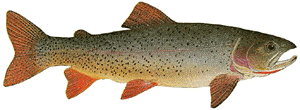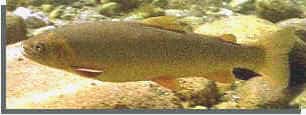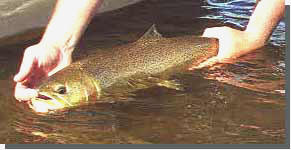In a day and age when it’s increasingly difficult to find a native trout, much less a native indigenous trout, it is comforting to know that there is a strong population of the Fine-spotted Snake River Cutthroat Trout, a unique subspecies of cutthroat, residing right here in Jackson Hole. Cutthroats originally ranged throughout the Intermountain West and are, in fact, the only species of trout native to the area. They are, however, more sensitive to environmental degradation and pollution than other species of trout and have been largely wiped out in much of their native habitat. It takes pure clean water to raise and sustain a viable cutthroat population. Fortunately, that is exactly what we enjoy here in Jackson Hole, and our cutthroats are doing quite well, thank you.
of trout native to the area. They are, however, more sensitive to environmental degradation and pollution than other species of trout and have been largely wiped out in much of their native habitat. It takes pure clean water to raise and sustain a viable cutthroat population. Fortunately, that is exactly what we enjoy here in Jackson Hole, and our cutthroats are doing quite well, thank you.
The Snake River Cutthroat is thought to have evolved along with the Yellowstone Cutthroat before parting ways at the onset of the last Ice Age, eleven thousand years ago. A geological separation took place at that time, keeping the two subspecies apart. In fact, it is quite easy to distinguish the two, though they share the distinctive bright, almost florescent, orange/red slash under the jaw common to all cutthroats.
Understandably, the Wyoming Game & Fish Department is anxious to maintain the viability of this wonderful species of trout. For that reason you won’t find stocking programs of other trout species, including the Snake River Cutthroat, in the Snake River. What remains is a native trout that still inhabits the waters in which it evolved, a rare and fortuitous combination. Remnant populations of other trout species from long discontinued stocking programs still exist, but are rarely caught, and will probably disappear eventually.
It’s not hard to understand why stocking other species of trout, such as browns and rainbows, is not even considered.
A Harsh Environment
The Snake River Cutthroat Trout has a tough life due to the harsh Jackson Hole environment. While summers are mild and very comfortable, they are somewhat short. Winters, by contrast, are long and cold. Wyoming Game & Fish tells us there is, on average, a 65% mortality rate among cutthroats throughout a typical winter.
This is undoubtedly due, at least in part, to the low winter flows the cutthroats are all too often subjected to. Winter water flows out of Jackson Lake Dam are regulated by the Bureau of Reclamation, a self-aggrandizing branch of the Department of the Interior.
In a typical year, the Bureau of Reclamation will begin reducing Snake River water flows at Jackson Lake Dam in October to ensure Jackson Lake is topped off and full by the end of runoff season. The primary reason for this concern is to make sure there is adequate water with which to irrigate crops in Idaho. I’ve said it before, and I’ll say it again, the vast majority of the time it is not necessary to reduce flows, to the detriment of the cutthroat, to the degree the Bureau of Reclamation feels is necessary.
season. The primary reason for this concern is to make sure there is adequate water with which to irrigate crops in Idaho. I’ve said it before, and I’ll say it again, the vast majority of the time it is not necessary to reduce flows, to the detriment of the cutthroat, to the degree the Bureau of Reclamation feels is necessary.
Not uncommonly, the Bureau will drastically reduce winter flows in the Snake only to fill Jackson Lake too soon (in other words, there is much snowpack yet to melt). In such cases the Bureau will then be forced to increase releases at Jackson Lake Dam at a time when the river may already be raging with runoff. Needless to say, neither the reduced winter flows nor the increased flows during runoff are beneficial to the cutthroat.
The end result of this harsh environment, whether natural or man made, is that the cutthroat will typically live shorter lives than other species of trout located in more moderate climates. If a Snake River Cutthroat lives six years it is doing well. Other trout may live eight years or more. Percentage wise, that’s quite a difference.
Cutthroats As Game Fish
Yet through it all, the cutthroat manages to hang in there. And its harsh environment makes significant contributions to the behavior, specifically feeding behavior, of the cutthroat.
Its relatively short growing season combined with a biological imperative to “fatten up” for winter makes the cutthroat an aggressive feeder when compared to other trout living in more sedentary conditions. Additionally, the Snake River is known for its relatively sparse hatches. For the fly fisherman this is really more of a blessing than a curse because it makes the cutthroat an opportunistic feeder that doesn’t necessarily key in on only one type of insect. Large dry flies like Turck Tarantulas, Stimulators, and Jay-Dave’s Hopper are very effective during most of the season. So are streamers like the JJ Special. Combine the cutthroats natural aggressiveness with its propensity for taking dry flies and you’re left with a trout that is extremely fun to fish for.

Threats To The Snake River Cutthroat
Having already discussed low winter flows I won’t elaborate further other than to say that low flows are the number one reason winter mortality rates for the Snake River Cutthroat are so high. Give them more water over the winter and they will have better survival rates. To be fair I must mention that the last three or four years have seen better winter flows and the fishery is in very good condition right now. Whether the higher flows are due to the substantial winter snowpack during those years or the Bureau of Reclamations new found sensitivity to our trout streams remains to be seen. Let’s hope it’s the latter.
The increasing development and growth of Jackson Hole poses another threat. Non-point source pollution not to mention a proposed nuclear incinerator downwind of Jackson Hole in Idaho have the potential to adversely affect the water quality required for healthy cutthroats. But development brings another insidious threat…levees.
Levee construction along the Snake River began in the early 1950’s under the auspices of the Army Corps of Engineers. Since that time, the levee system has been continually added to despite the destruction documented by the Corps own scientific evidence. The Corps has, in fact, violated and steadfastly ignored its own guidelines for levee construction which stipulate that the cumulative impact of all levees must be taken into consideration before new permits for levee construction can be issued.
The Snake is a large fast brawling river with an inclination to braid and spread out over it’s flood plain. Wealthy and influential second-home owners have been flocking to Jackson Hole in recent years and too many new homes (i.e. mansions) are being built in the Snake’s 100 year flood plain. Once built, these homes are annually threatened by spring runoff. That is unless you build, with the Corps blessing, a levee along the river to protect your house and property.
The problem with levees is that they constrict the flows of a high-energy river that wants to channel and spread out in order to dissipate some of that energy. Levees tend to constrain the river to one single large channel. By constricting flows and limiting channelization, levees serve to further increase water velocity. The result is increased erosion between levees and the consequent destruction of cutthroat and wildlife habitats. The habitat loss caused since levee construction first began is astounding.
Cutthroats, like all trout, require a specific sized gravel in a streambed in order to spawn successfully. Levees block access to this specialized spawning habitat, which is found in the many spring creeks feeding the river. Cutthroat cannot spawn successfully in the main river, they need the relative sanctuary provided by the spring creeks. The resulting reduction in available spawning grounds has been significant.
In the mean time, the spring creeks (now residing behind the levee system) are silting up due to a lack of flushing flows from the Snake River proper. Flushing flows would normally occur during spring runoff, but no longer reach the spring creeks because of the levees. Once silted, the spring creeks do not provide viable spawning habitats and require human intervention to be restored.
To summarize, though the Snake River Cutthroat is currently doing well, significant threats loom on the horizon. If we fail to take appropriate action now, we risk losing this irreplaceable resource. Don’t think it can’t happen. The legacy of the cutthroat is a testament to the fact that it can.
